Site Guide to Hope Airport
by Thor Manson (updated March 7, 2012 by Gord Gadsden)
The following report is based on the personal observations of the reporter, as well as those of a few others. It is not a comprehensive record of birding in the region, and other birders may have observed additional species to those mentioned.
Hope Airport occupies a unique site, both within the context of the Hope Region, and the eastern end of the Fraser Valley. Like most of the eastern Fraser Valley, it is enclosed by the Cascade Mountains to the East and the Coastal Mountains to the West. At this point, the valley is considerably more narrow than in the Chilliwack area. The area is often compared to the narrow end of a funnel, and the prevailing westerly winds will occasionally be strong and blustery, as the air is funneled into a more narrow space. This affect also occasionally causes poor air quality, especially in the summer.
The Hope Region is usually considered to be the most south easterly point of the Pacific Coastal Marine Climatic Zone in B.C., and its accompanying vegetative systems. Travel further north into the Fraser Canyon, and north and east up into the Cascades, will very quickly find the traveler in significantly different ecosystems. This, in turn, causes the bird life to vary considerably within a relatively small amount of geographic space.
Specifically, the airport is bordered on the north by mixed forest, smaller parcels of agricultural land, 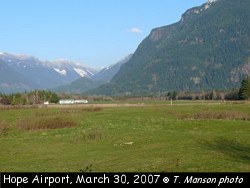 and its accompanying residences, and the Fraser River and Bristol Slough. To the south is a narrow strip of mixed forest, and the CNR Railway tracks. To the East is more mixed forest, and residences with acreages, and to the west are more farms, one of them being certified organic. The airport itself consists of small buildings and hangars. It is home to the Vancouver Soaring Association, which uses it extensively on weekends in the spring, summer. and fall. The rest of the property is planted grass which is mostly kept cut to accommodate the planes. The airstrip is fenced and is technically off limits. However any part of the property can be birded from the outside with binoculars and/or a scope. The airstrip is surrounded by a paved road, which bears little traffic. It is 4 km around, and the locals, as well as visitors, use the road as a recreational walkway. This makes the site a very pleasant place to bird. With the airport grassland prevailing, the airport, and the surrounding land and water presents a variety of ecosystems to both resident and migratory birds. The funnel affect, previously mentioned, can also occasionally produce circumstances during the migratory periods, especially spring, when birds are trapped in the area due to bad weather. This can produce a and its accompanying residences, and the Fraser River and Bristol Slough. To the south is a narrow strip of mixed forest, and the CNR Railway tracks. To the East is more mixed forest, and residences with acreages, and to the west are more farms, one of them being certified organic. The airport itself consists of small buildings and hangars. It is home to the Vancouver Soaring Association, which uses it extensively on weekends in the spring, summer. and fall. The rest of the property is planted grass which is mostly kept cut to accommodate the planes. The airstrip is fenced and is technically off limits. However any part of the property can be birded from the outside with binoculars and/or a scope. The airstrip is surrounded by a paved road, which bears little traffic. It is 4 km around, and the locals, as well as visitors, use the road as a recreational walkway. This makes the site a very pleasant place to bird. With the airport grassland prevailing, the airport, and the surrounding land and water presents a variety of ecosystems to both resident and migratory birds. The funnel affect, previously mentioned, can also occasionally produce circumstances during the migratory periods, especially spring, when birds are trapped in the area due to bad weather. This can produce a 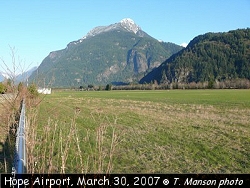 condition called fallout, where large numbers of one or more species of birds are temporarily trapped in the area, hemmed in by the mountains, and weather conditions. condition called fallout, where large numbers of one or more species of birds are temporarily trapped in the area, hemmed in by the mountains, and weather conditions.
Although there are times when the airport seems devoid of any birds, there are other times when it is very active in both the quantity, and diversity of bird life. Perhaps because of the reasons stated above, there have been a number of rarities sighted here. These include sight records of nesting Bobolink , Rustic Bunting as well as documented Scissor-tailed Flycatcher in two consecutive years in 1994 and 1995 and a sight record in 2008, Chestnut-collared Longspur (2010), Yellow-breasted Chat (2010), Blue-headed Vireo (2010) and Hoary Redpoll (2012).
Winter
As with many parts of the Hope Region, the airport lies in the shadow of the Cascade Mountains, and can be devoid of direct sunlight, even on sunny days. This produces cooler than normal conditions. Nevertheless, birds continue to occupy the area. The resident Alaskan Song Sparrow is always present, as are Winter Wrens , both the Chestnut-backed and Black-capped Chickadee , Steller's Jay , Spotted Towhee and Red-breasted Nuthatch. Dark-eyed Juncos are never that far away. Common Raven is also present. The Hope area is considered to be the rough dividing line between the limits of the 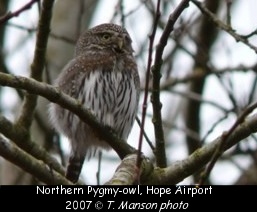 Northwestern and American Crows . Both are present, but good luck telling one from the other! There is still the odd American Robin about, but they are mostly replaced by their cousins in the thrush family, the Varied Thrush. Raptors are predominant. Bald Eagles are around, especially during early winter, feeding on salmon carcasses. The ubiquitous Red-tailed Hawk is seen, and is joined by Cooper's Hawk, and Rough-legged Hawk, although the latter is not common. Sharp-shinned Hawk will harass birds at feeders. A Long-Eared Owl was seen in the area during the winter of 05/06, and Northern Pygmy and Barred Owls are fairly regular. Northern Shrikes are observed regularly, hunting from perches, and Golden-crowned, and Ruby-crowned Kinglets are occasionally seen. The predominant gull here at any time of the year is the Glaucous-winged Gull, and will more likely be found near the river than around the airport proper. Northern Flickers are permanent residents, and both Hairy and Downy Woodpeckers frequent local suet feeders. Red-breasted Sapsuckers become more prominent in the spring. In irruptive years, Common Redpolls are seen feeding in the area, and about as frequently, Pine Grosbeaks will be seen. Northwestern and American Crows . Both are present, but good luck telling one from the other! There is still the odd American Robin about, but they are mostly replaced by their cousins in the thrush family, the Varied Thrush. Raptors are predominant. Bald Eagles are around, especially during early winter, feeding on salmon carcasses. The ubiquitous Red-tailed Hawk is seen, and is joined by Cooper's Hawk, and Rough-legged Hawk, although the latter is not common. Sharp-shinned Hawk will harass birds at feeders. A Long-Eared Owl was seen in the area during the winter of 05/06, and Northern Pygmy and Barred Owls are fairly regular. Northern Shrikes are observed regularly, hunting from perches, and Golden-crowned, and Ruby-crowned Kinglets are occasionally seen. The predominant gull here at any time of the year is the Glaucous-winged Gull, and will more likely be found near the river than around the airport proper. Northern Flickers are permanent residents, and both Hairy and Downy Woodpeckers frequent local suet feeders. Red-breasted Sapsuckers become more prominent in the spring. In irruptive years, Common Redpolls are seen feeding in the area, and about as frequently, Pine Grosbeaks will be seen.
Spring into Summer
As elsewhere in temperate climates, spring signals the return of many neotropical birds, and also gives local birders an opportunity to see birds that are migrating through on their way to breeding destinations north, and east. Tree Swallows are amongst the first arrivals. The organic farm, located at the western end of the airport area is a particularly attractive spot for swallows. Besides Tree, Barn, and Violet-Green Swallows, Cliff Swallows will nest on the property. Later in the spring, scan the skies for Vaux's and Black Swifts . American Robins dramatically increase in number, and a number of other resident birds, previously mentioned, start their nesting behaviours. Look for Brewer's Blackbirds around the Interfor property. Rufous Hummingbirds are attracted by flowering Red Currant bushes, and the Alaskan Song Sparrow is joined by Savannah and White-crowned Sparrows as the predominant spring and summer sparrows. Occasionally, Lincoln, and Vesper Sparrows will also be seen, the former, usually migrating through. Yellow-rumped Warbler is usually the first warbler to be observed around the property, and later, they are joined by Orange-crowned, Wilson's, and Yellow Warblers. Common Yellowthroats will nest in the tall weeds/wildflowers bordering the north side of the airstrip. With the return of the small 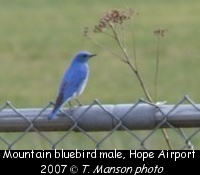 passerines, the American Kestrel becomes a prominent raptor around the airstrip, often seen perched on overhead wires, scanning the grasslands for prey. The Northern Harrier is probably around all year, but is most noticeable from spring until late fall. Swainson's Hawk are casual migrants in the spring and fall. As for flycatchers, The Western Wood-PeeWee, Olive-sided Flycatcher, and Eastern and Western Kingbirds are the most common. Red-eyed, and Warbling Vireos are also present. Western Tanagers can be looked for, and are always a pleasure to see, especially the males, with their bright plumage. Many Turkey Vultures can be seen continuously soaring aloft on the abundant thermals produced around this area. Band-tailed Pigeons breed in the area. Look for them roosting in a tall fir tree at the south east corner of the airport. Barn Owls can be seen hunting over the airport property at night. Other birds to look for around the passerines, the American Kestrel becomes a prominent raptor around the airstrip, often seen perched on overhead wires, scanning the grasslands for prey. The Northern Harrier is probably around all year, but is most noticeable from spring until late fall. Swainson's Hawk are casual migrants in the spring and fall. As for flycatchers, The Western Wood-PeeWee, Olive-sided Flycatcher, and Eastern and Western Kingbirds are the most common. Red-eyed, and Warbling Vireos are also present. Western Tanagers can be looked for, and are always a pleasure to see, especially the males, with their bright plumage. Many Turkey Vultures can be seen continuously soaring aloft on the abundant thermals produced around this area. Band-tailed Pigeons breed in the area. Look for them roosting in a tall fir tree at the south east corner of the airport. Barn Owls can be seen hunting over the airport property at night. Other birds to look for around the 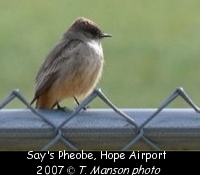 property at this time of year include Black-Headed Grosbeak, Evening Grosbeak, Lazuli Bunting, Brown Creepers, Townsend's Solitaire, Swainson's Thrush, Cedar Waxwing, American Redstart ( migratory ), Brown-Headed Cowbird, American Goldfinch, Pine Siskin, Mountain Bluebird, and Say's Phoebe; ( migratory ). Over on Bristol Slough, and the Fraser River, there are a number of birds to look for. Mallard, and Common Merganser are the two most common ducks. Spotted Sandpiper nests along the slough. Double-crested Cormorant, and Great Blue Heron are also here. Osprey can be seen fishing over the river. Driving down to the Fraser River on Bristol Slough and Roads takes the birder through some densely treed parts of the region, and birds of the forest described above, can sometimes be more easily observed there. property at this time of year include Black-Headed Grosbeak, Evening Grosbeak, Lazuli Bunting, Brown Creepers, Townsend's Solitaire, Swainson's Thrush, Cedar Waxwing, American Redstart ( migratory ), Brown-Headed Cowbird, American Goldfinch, Pine Siskin, Mountain Bluebird, and Say's Phoebe; ( migratory ). Over on Bristol Slough, and the Fraser River, there are a number of birds to look for. Mallard, and Common Merganser are the two most common ducks. Spotted Sandpiper nests along the slough. Double-crested Cormorant, and Great Blue Heron are also here. Osprey can be seen fishing over the river. Driving down to the Fraser River on Bristol Slough and Roads takes the birder through some densely treed parts of the region, and birds of the forest described above, can sometimes be more easily observed there.
Fall 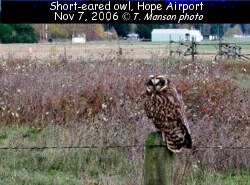
This time of year gives birders the opportunity to see more migratory birds such as warblers, sparrows, flycatchers and the likes as they head back south. On the slough, Greater Yellowlegs are amongst the species that have been noted. Long-billed Curlew showed up on Jack's farm for the first sighting of the species in the area. American Pipits, sometimes accompanied by Horned Larks, will be seen in large flocks foraging in the short grass of the airport, and Short-eared Owls will be seen competing with Northern Harriers, as they course over the grasslands.
Access
Access to the Hope Airport, and surrounding areas is easy. Coming from East or West on the Transcanada Highway, take exit 165 or 168, cross the freeway, if coming from the West, and then cross the railway tracks, and you are there. Access to Bristol Slough, and the Fraser River is via Bristol Slough Rd off the airport perimeter Rd, by Interfor, or by turning north off Yale Rd, by the railway crossing. Access to the organic farm, down Delair Rd. , is by permission only. The owner, however, is a birder, and regularly welcomes birders to look around his acreage. Parking at the airport is in the actual terminal parking lot, or on the grassy verge which runs along the north side of the airstrip; ( please don't block any gates in the metal fence ). Elsewhere it is possible to pull a vehicle mostly off the road. |